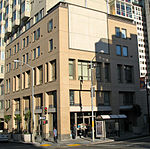Barbary Coast, San Francisco
The Barbary Coast was a red-light district during the second half of the 19th and early 20th centuries in San Francisco that featured dance halls, concert saloons, bars, jazz clubs, variety shows, and brothels. Its nine block area was centered on a three block stretch of Pacific Street, now Pacific Avenue, between Montgomery and Stockton Streets. Pacific Street was the first street to cut through the hills of San Francisco, starting near Portsmouth Square and continuing east to the first shipping docks at Buena Vista Cove. The Barbary Coast was born during the California Gold Rush of 1849, when the population of San Francisco was growing at an exponential rate due to the rapid influx of tens of thousands of miners trying to find gold. The early decades of the Barbary Coast were marred by persistent lawlessness, gambling, administrative graft, vigilante justice, and prostitution; however with the passage of time, the city's government gained strength and competence, and the Barbary Coast's maturing entertainment scene of dance halls and jazz clubs influenced American culture. The Barbary Coast's century-long evolution passed through many substantial incarnations due to the city's rapid cultural development during the transition to the 20th century. Its former location now is overlapped by Chinatown, North Beach, and Jackson Square.
Excerpt from the Wikipedia article Barbary Coast, San Francisco (License: CC BY-SA 3.0, Authors).Barbary Coast, San Francisco
Jackson Street, San Francisco
Geographical coordinates (GPS) Address Nearby Places Show on map
Geographical coordinates (GPS)
| Latitude | Longitude |
|---|---|
| N 37.79656 ° | E -122.40593 ° |
Address
Jackson Street 640;644;648
94133 San Francisco
California, United States
Open on Google Maps









